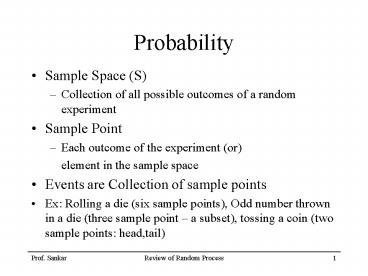Probability - PowerPoint PPT Presentation
Title:
Probability
Description:
Characteristic Function (moment generator) Prof. Sankar. Review of Random Process. 22 ... Stationary Process : Statistical characteristics of the sample ... – PowerPoint PPT presentation
Number of Views:21
Avg rating:3.0/5.0
Title: Probability
1
Probability
- Sample Space (S)
- Collection of all possible outcomes of a random
experiment - Sample Point
- Each outcome of the experiment (or)
- element in the sample space
- Events are Collection of sample points
- Ex Rolling a die (six sample points), Odd number
thrown in a die (three sample point a subset),
tossing a coin (two sample points head,tail)
2
Probability
- Null Event (No Sample Point)
- Union (of A and B)
- Event which contains all points in A and B
- Intersection (of A and B)
- Event that contains points common to A and B
- Law of Large Numbers
- N number of times the random experiment is
repeated - NA- number of times event A occurred
3
Probability
- Properties
4
Probability
- Conditional Probability
- Probability of B conditioned by the fact that A
has occurred - The two events are statistically independent if
5
Probability
- Bernoullis Trials
- Same experiment repeated n times to find the
probability of a particular event occurring
exactly k times
6
Random Signals
- Associated with certain amount of uncertainty and
unpredictability. Higher the uncertainty about a
signal, higher the information content. - For example, temperature or rainfall in a city
- thermal noise
- Information is quantified statistically
- (in terms of average (mean), variance, etc.)
- Generation
- Toss a coin 6 times and count the number of heads
- x(n) is the signal whose value is the number of
heads on the nth trial
7
Random Signals
- Mean
- Median Middle or most central item in an ordered
set of numbers - Mode Maxxi
- Variance
- Standard Deviation
- measure of spread or deviation from the mean
8
Random Variables
- Probability is a numerical measure of the outcome
of the random experiment - Random variable is a numerical description of the
outcome of a random experiment, i.e., arbitrarily
assigned real numbers to events or sample points - Can be discrete or continuous
- For example head is assigned 1
- tail is assigned 1 or 0
9
Random Variables
- Cumulative Distribution Function (CDF)
- Properties
- Probability Density Function (PDF)
- Properties
10
Important Distributions
- Binary distribution (Bernoulli distribution)
- Random variable has a binary distribution
- Partitions the sample space into two distinct
subsets A and B - All elements in A are mapped into one number say
1 and B to another number say 0.
11
Important Distributions
- Binomial Distribution
- Perform binary experiment n times with outcome
X1,X2,Xn, if , then X has
binomial distribution
12
Important Distributions
- Uniform Distribution
- Random variable is equally likely
- Equally Weighted pdf
13
Important Distributions
- Poisson Distribution
- Random Variable is Poisson distributed
with parameter m with - Approximation to binomial with p ltlt 1,
and k ltlt 1, then
14
Important Distributions
- Gaussian Distribution
- Normalized Gaussian pdf - N(0,1)
- Zero mean, Unit Variance
15
Important Distributions
- Normalized Gaussian pdf
16
Joint and Conditional PDFs
- For two random variables X and Y
17
Joint and Conditional PDFs
- Marginal pdfs
- Conditional pdfs
18
Expectation and Moments
- Centralized Moment
- Second centralized moment is variance
19
Expectations and Moments
- (i,j) joint moment between random variables X and
Y
20
Expectations and Moments
- (i,j) joint central moment
21
Expectations and Moments
- Auto-covariance
- Characteristic Function (moment generator)
22
Random Process
- If a random variable X is a function of another
variable, say time t, x(t) is called random
process - Collection of all possible waveforms is called
the ensemble - Individual waveform is called a sample function
- Outcome of a random experiment is a sample
function for random process instead of a single
value in the case of random variable
23
Random Process
- Random Process X(.,.) is a function of time
variable t and sample point variable s - Each sample point (s) identifies a function of
time X(.,s) referred as sample function - Each time point (t) identifies a function of
sample points X(t,.), i.e., a random variable - Random or Stochastic Processes can be
- continuous or discrete time process
- continuous or discrete amplitude process
24
Random Process
- Ensemble statistic Ensemble average at a
particular time - Temporal average for a sample function
- Random Process Classifications
- Stationary Process Statistical characteristics
of the sample function do not change with time
(time-invariant)
25
Random Process
- Second Order joint pdf
- Autocorrelation is a function of only time
difference - Wide Sense (or Weak) Stationary
- Independent of time up to second order only
- Ergodic Process
- Ensemble average time average
26
Random Process
- Mean
- Mean of the random process at time t is the mean
of the random variable X(t) - Autocorrelation
- Auto-covariance
27
Random Process
- Cross Correlation and covariance
- Power Density Spectrum
28
Random Process
- Total Average Power































